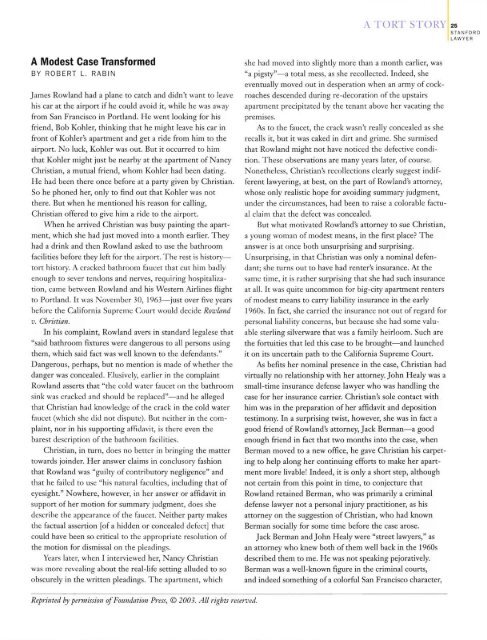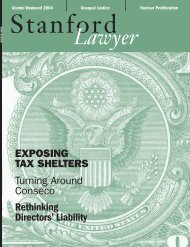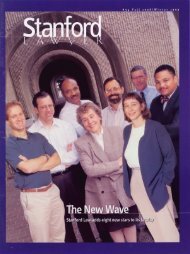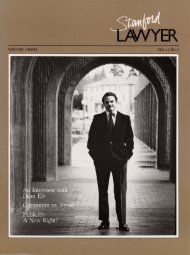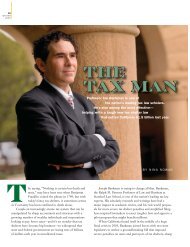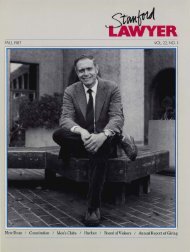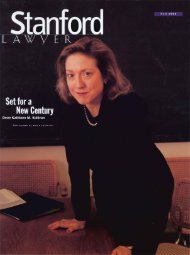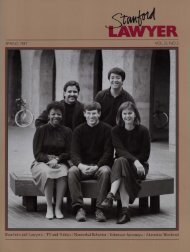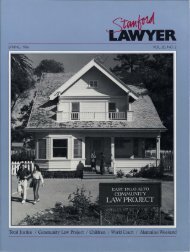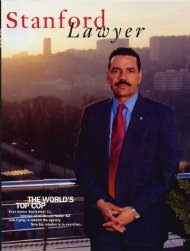Summer 2003 – Issue 66 - Stanford Lawyer - Stanford University
Summer 2003 – Issue 66 - Stanford Lawyer - Stanford University
Summer 2003 – Issue 66 - Stanford Lawyer - Stanford University
- No tags were found...
You also want an ePaper? Increase the reach of your titles
YUMPU automatically turns print PDFs into web optimized ePapers that Google loves.
'\ TORT STOR1 T 25STANFOROLAWY ERA Modest Case TransformedBY ROBERT L. RABINJames Rowland had a plane to catch and didn't want to leavehis car at the airport if he could avoid it, while he was awayfrom San Francisco in Portland. He went looking for hisfriend, Bob Kohler, thinking that he might leave his car infront of Kohler's apartment and get a ride from him to theairport. No luck, Kohler was out. But it occurred to himthat Kohler might just be nearby at the apartment of NancyChristian, a mutual friend, whom Kohler had been dating.He had been there once before at a party given by Christian.So he phoned her, only to find out that Kohler was notthere. But when he mentioned his reason for calling,Christian offered to give him a ride to the airport.When he arrived Christian was busy painting the apartment,which she had just moved into a month earlier. Theyhad a drink and then Rowland asked to use the bathroomfacilities before they left for the airport. The rest is historytorthistory. A cracked bathroom faucet that cut him badlyenough to sever tendons and nerves, requiring hospitalization,came between Rowland and his Western Airlines flightto Portland. It was November 30, 1963-just over five yearsbefore the California Supreme Court would decide Rowlandv. Christian.In his complaint, Rowland avers in standard legalese that"said bathroom fixtures were dangerous to all persons usingthem, which said fact was well known to the defendants."Dangerous, perhaps, but no mention is made of whether thedanger was concealed. Elusively, earlier in the complaintRowland asserts that "the cold water faucet on the bathroomsink was cracked and should be replaced"-,llld he allegedthat Christian had knowledge of the crack in the cold waterfaucet (which she did not dispute). But neither in the complaint,nor in his supporting affidavit, is there even thebarest description of the bathroom facilities.Christian, in turn, does no better in bringing the mattertowards joinder. Her answer claims in conclusory fashionthat Rowland was "guilty of contributory negligence" andthat he failed to use "his natural faculties, including that ofeyesight." Nowhere, however, in her answer or affidavit insupport of her motion for summary judgment, does shedescribe the appearance of the faucet. Neither party makesthe factual assertion [of a hidden or concealed defect] thatcould have been so critical to the appropriate resolution ofthe motion for dismissal on the pleadings.Years later, when I interviewed her, ancy Christianwas more revealing about the real-life setting alluded to soobscurely in the written pleadings. The apartment, whichshe had moved into slightly more than a month earlier, was"a pigsty"-a total mess, as she recollected. Indeed, sheeventually moved out in desperation when an army of cockroachesdescended during re-decoration of the upstairsapartment precipitated by the tenant above her vacating thepremIses.As to the faucet, the crack wasn't really concealed as sherecalls it, but it was caked in dirt and grime. She surmisedthat Rowland might not have noticed the defective condition.These observations are many years later, of course.Nonetheless, Christian's recollections clearly suggest indifferentlawyering, at best, on the part of Rowland's attorney,whose only realistic hope for avoiding summary judgment,under the circumstances, had been to raise a colorable factualclaim that the defect was concealed.But what motivated Rowland's attorney to sue Christian,a young woman of modest means, in the first place? Theanswer is at once both unsurprising and surprising.Unsurprising, in that Christian was only a nominal defendant;she turns out to have had renter's insurance. At thesame time, it is rather surprising that she had such insuranceat all. It was quite uncommon for big-city apartment rentersof modest means to carry liability insurance in the early1960s. In fact, she carried the insurance not out of regard forpersonal liability concerns, but because she had some valuablesterling silverware that was a family heirloom. Such arethe fortuities that led this case to be brought-and launchedit on its uncertain path to tile California Supreme Court.As befits her nominal presence in the case, Christian hadvirtually no relationship with her attorney. John Healy was asmall-time insurance defense lawyer who was handling thecase for her insurance carrier. Christian's sole contact withhim was in the preparation of her affidavit and depositiontestimony. In a surprising twist, however, she was in fact agood friend of Rowland's attorney, Jack Berman-a goodenough friend in fact that two months into the case, whenBerman moved to a new office, he gave Christian his carpetingto help along her continuing efforts to make her apartmentmore livable! Indeed, it is only a short step, althoughnot certain from this point in time, to conjecture thatRowland retained Berman, who was primarily a criminaldefense lawyer not a personal injury practitioner, as hisattorney on the suggestion of Christian, who had knownBerman socially for some time before the case arose.Jack Berman and John Healy were "street lawyers," asan attorney who knew both of them well back in the 1960sdescribed them to me. He was not speaking pejoratively.Berman was a well-known figure in the criminal courts,and indeed something of a colorful San Francisco character,Reprinted by permission ofFoundation Prm, © <strong>2003</strong>. All rights l'eSel'1Jed.


